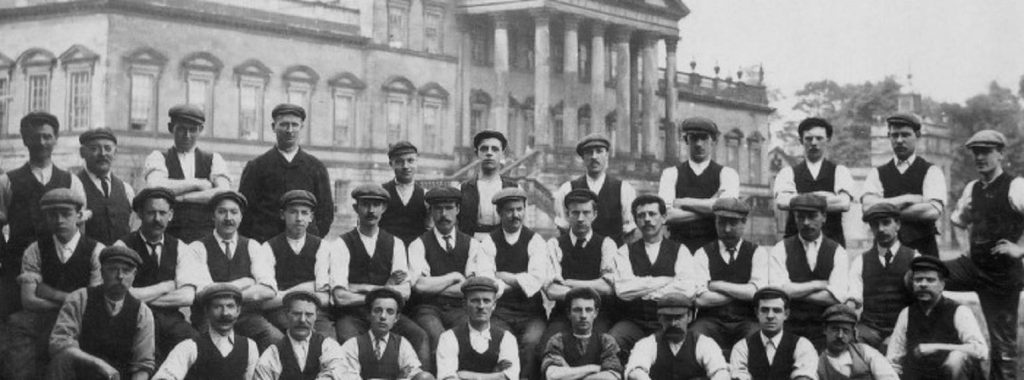If there is one book which has propelled the story of Wentworth Woodhouse into the public eye it is Black Diamonds by Catherine Bailey.
From unbelievable wealth to waves of colossal devastation, Bailey’s fascinating portrayal of the Fitzwilliam family is hard to beat. And now, fans of the best-seller can relive the plight of Wentworth Woodhouse with a 90-minute tour that includes several rooms never-before seen by the public.
The Black Diamonds tour has been created by Catherine to bring to life the stories told in her book to the very rooms where events, scandal and feuds happened. With a focus on the people from the house’s heyday in the late 1800s, the Black Diamonds tour also looks at how the house came to be what it is today through the demise of the Fitzwilliam family.

“The book has been so successful partly because of it is a tragic story of epic proportions – it is so extraordinary how it all ended that you couldn’t make it up. It’s full of intrigue and strikes a chord with people whose families lived and worked in the area. But it also has a wider appeal throughout the country due to the affluence and outrageous stories of this elite and powerful family,” Catherine says.
For those who haven’t read Black Diamonds, the book relays previously unknown stories and the many twists and turns that resulted in decay and decline of this grand stately home. It tells how, in one catastrophic decade after the Second World War, the privileged way of life at the house ended abruptly with devastating consequences.
Catherine wrote Black Diamonds in the early 2000s after becoming entranced with the story of the house and the family which once lived there.
“I was a TV producer doing a series up that way and it was suggested I should go and see Wentworth Woodhouse. This was in 1999 when it was all boarded up and abandoned, but I couldn’t believe the scale of it or that I’d never heard of it. Someone called it England’s forgotten palace and their description couldn’t be more correct. It haunted me.”
After doing lots of research over many years, Catherine began piecing together the history behind the crumbling façade. Unable to access the Fitzwilliam family records, she had to scour public archive records and contact countless people who had a connection to the house.
“The research was a hugely laborious task and a gargantuan effort which took four years to collaborate due to the very little obvious material I could initially find. The memories of distant relative and villagers were invaluable. There was a visitor book in the house and I wrote to every entry to see if they had any stories or letters in their private archives.”
Black Diamonds not only looks at the aristocracy but also pays tribute to the miners from whom the Earls made their wealth. Catherine says it is this connection to coal mining and the South Yorkshire Coalfield which really captivated her interest.

“I’ve had an affinity to coal mining ever since I was sent to live in a mining village in Wales during the miners’ strike in the mid-80s. I met a four-generational family of miners who told me about their lives and that of their ancestors which was just fascinating. I think I was the first woman to go underground at Lady Windsor Colliery which had a leading role in the strike.
“For the mining sections in the book I read many a pit worker’s memoir and spoke to lots of people who either worked down at the collieries in the area or were descendants of miners.”
The tour launched in October and visitors can retrace the steps of the Fitzwilliam family and their many staff. It is packed with detail about the immense workload staff had to undertake on a daily basis, more so when the Earls threw weekend parties.
“William, the 6th Earl Fitzwilliam, was incredibly rich; in his lifetime his wealth increased 1,000-fold and he’d regularly entertain up to 50 aristocratic guests. His son Billy, the 7th Earl, was more flamboyant and his guests included royalty, Winston Churchill, Ginger Rogers and Charlie Chaplin.
“Weekend parties ran from Thursday to Tuesday and people wore at least four outfits a day. On Thursday morning the Pillared Hall would be crammed with luggage and 60 servants searching trunks, gun cases and hat boxes for their owners’ initials and ensuring everything went to the right rooms, while 40 footmen waited for the guests to arrive.
“The house had no running water and only fireplaces for heat. Electricity wasn’t introduced until 1904 so maids, lamp men and water men toiled around the clock just to keep guests comfortable.”

Tour guides will take visitors around parts of the house that have remained private since tours began, such as the Earl’s private toilet which was the only one in the house at the time. You can see the servant’s quarters where staff would prepare banquets for thousands, take a look at the Earl’s private living quarters, and also see the guests’ quarters where King George V would have stayed during his Royal visit in 1912.
The Black Diamond Tour takes place daily from Wednesday to Sunday and costs £25 per visitor. For more information, go to www.wentworthwoodhouse.org.uk/events






